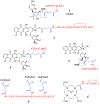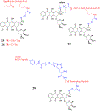Peptide-Drug Conjugates with Different Linkers for Cancer Therapy
- PMID: 33382619
- PMCID: PMC8610607
- DOI: 10.1021/acs.jmedchem.0c01530
Peptide-Drug Conjugates with Different Linkers for Cancer Therapy
Abstract
Drug conjugates are chemotherapeutic or cytotoxic agents covalently linked to targeting ligands such as an antibody or a peptide via a linker. While antibody-drug conjugates (ADCs) are now clinically established for cancer therapy, peptide-drug conjugates (PDCs) are gaining recognition as a new modality for targeted drug delivery with improved efficacy and reduced side effects for cancer treatment. The linker in a drug conjugate plays a key role in the circulation time of the conjugate and release of the drug for full activity at the target site. Herein, we highlight the main linker chemistries utilized in the design of PDCs and discuss representative examples of PDCs with different linker chemistries with the related outcome in cell and animal studies.
Conflict of interest statement
The authors declare no competing financial interest.
Figures












Similar articles
-
Current progress and remaining challenges of peptide-drug conjugates (PDCs): next generation of antibody-drug conjugates (ADCs)?J Nanobiotechnology. 2025 Apr 22;23(1):305. doi: 10.1186/s12951-025-03277-2. J Nanobiotechnology. 2025. PMID: 40259322 Free PMC article. Review.
-
Peptide Drug Conjugates and Their Role in Cancer Therapy.Int J Mol Sci. 2023 Jan 3;24(1):829. doi: 10.3390/ijms24010829. Int J Mol Sci. 2023. PMID: 36614268 Free PMC article. Review.
-
Navigating cancer therapy: Harnessing the power of peptide-drug conjugates as precision delivery vehicles.Eur J Med Chem. 2025 Feb 5;283:117131. doi: 10.1016/j.ejmech.2024.117131. Epub 2024 Dec 7. Eur J Med Chem. 2025. PMID: 39647418 Review.
-
Peptide-Drug Conjugate: A Novel Drug Design Approach.Curr Med Chem. 2017;24(31):3373-3396. doi: 10.2174/0929867324666170404142840. Curr Med Chem. 2017. PMID: 28393694 Review.
-
Drug conjugate-based anticancer therapy - Current status and perspectives.Cancer Lett. 2023 Jan 1;552:215969. doi: 10.1016/j.canlet.2022.215969. Epub 2022 Oct 22. Cancer Lett. 2023. PMID: 36279982 Review.
Cited by
-
β-Silyl alkynoates: Versatile reagents for biocompatible and selective amide bond formation.Sci Adv. 2024 Sep 20;10(38):eadp7544. doi: 10.1126/sciadv.adp7544. Epub 2024 Sep 18. Sci Adv. 2024. PMID: 39292777 Free PMC article.
-
Learn from antibody-drug conjugates: consideration in the future construction of peptide-drug conjugates for cancer therapy.Exp Hematol Oncol. 2022 Nov 8;11(1):93. doi: 10.1186/s40164-022-00347-1. Exp Hematol Oncol. 2022. PMID: 36348391 Free PMC article. Review.
-
Peptides Targeting HER2-Positive Breast Cancer Cells and Applications in Tumor Imaging and Delivery of Chemotherapeutics.Nanomaterials (Basel). 2023 Sep 1;13(17):2476. doi: 10.3390/nano13172476. Nanomaterials (Basel). 2023. PMID: 37686984 Free PMC article. Review.
-
Transformable Neuropeptide Prodrug with Tumor Microenvironment Responsiveness for Tumor Growth and Metastasis Inhibition of Triple-Negative Breast Cancer.Adv Sci (Weinh). 2023 Jul;10(21):e2300545. doi: 10.1002/advs.202300545. Epub 2023 May 5. Adv Sci (Weinh). 2023. PMID: 37147783 Free PMC article.
-
Prediction of the interaction between Calloselasma rhodostoma venom-derived peptides and cancer-associated hub proteins: A computational study.Heliyon. 2023 Oct 26;9(11):e21149. doi: 10.1016/j.heliyon.2023.e21149. eCollection 2023 Nov. Heliyon. 2023. PMID: 37954374 Free PMC article.
References
-
- Gotwals P; Cameron S; Cipolletta D; Cremasco V; Crystal A; Hewes B; Mueller B; Quaratino S; Sabatos-Peyton C; Petruzzelli L; Engelman JA; Dranoff G, Prospects for combining targeted and conventional cancer therapy with immunotherapy. Nat Rev Cancer 2017, 17 (5), 286–301. - PubMed
-
- Chau CH; Steeg PS; Figg WD, Antibody-drug conjugates for cancer. Lancet 2019, 394 (10200), 793–804. - PubMed
Publication types
MeSH terms
Substances
Grants and funding
LinkOut - more resources
Full Text Sources
Other Literature Sources
Medical

